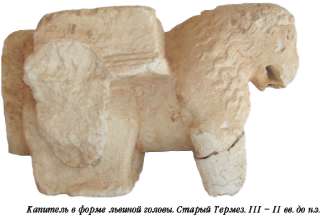 The decor of buildings of the antique epoch of Bactria enough studied, though it is still not studied remain important aspects of the problem. Among them – the definition of constructive and artistic tasks decor, the disclosure of their philosophical essence and religious-ideological interpretation, i.e. the problem of semantics. Interpretation of images of a number of architectural details found the lighting in the fundamental monograph LI. Ремпеля and scientific works of the GA. Pugachenkova. Information architecture the decoration and its reasons given some attention and in the monograph H.S.. Karomatov.
The decor of buildings of the antique epoch of Bactria enough studied, though it is still not studied remain important aspects of the problem. Among them – the definition of constructive and artistic tasks decor, the disclosure of their philosophical essence and religious-ideological interpretation, i.e. the problem of semantics. Interpretation of images of a number of architectural details found the lighting in the fundamental monograph LI. Ремпеля and scientific works of the GA. Pugachenkova. Information architecture the decoration and its reasons given some attention and in the monograph H.S.. Karomatov.
This article is devoted to the consideration of individual architectural forms and artistic images, which functionally divided into several groups.
In Eastern architecture of the wooden columns from the earliest times widely used for the maintenance of the design of floors aivans and large premises. The master of Bactria not left any information on the semantics of the wooden columns, and the Greeks claimed that the master assimilated the tree (wood columns) of a living organism: the barrel compared with bones, a new layer – with meat, crust – with the skin, the water, the blood and believed that these features are present in all types of tree”
Stone base, which served as the basis for wooden the columns were made in a special machines from a local limestone two types – “аттические” and “торовидные”. Top these databases include two geometric shapes – square and in the circle, it fit. It is thought, that the ancient masters of the data forms are not interpreted by some religious or philosophical the ideas. However, these two traditional geometric forms can be found not only in the architecture, but also in the fine and the applied art and olden time have a unique semantics.
Square – one of the four main characters – the symbol of the the land of the sky, but also a symbol of the universe and space. His form expresses the idea of the антидинамичности and stagnation. In astrology square denotes the shape of the earth, matter and limitations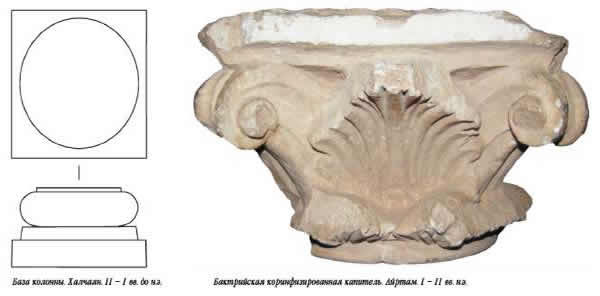 .
.
The circle also one of the four characters representing a the movement, the sky, infinity, the reality, time, protection and etc., which has a total symbolic feature and is associated with fire, heroes, the worship of the gods. Geometric element, included in the composition of the arch and volute – a triangle. In addition to architectural details of Bactria he used in decorative friezes India, Greece and Rome. The top of the triangle, aimed up, it is the mountain, fire and creative man’s strength; down – symbols of the mountains, the water passing through the mountains, fertility and female beginning. An isosceles triangle – a symbol of the deity, harmony and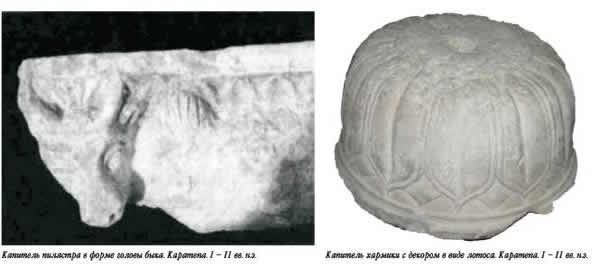 the proportion.
the proportion.
Constructive and decorative element of the columns, included in the system of the order of the ancient architecture, is a small-caps font. Usually it served as a uniform distribution of the gravity beams on the pillars. Existed in ancient times wooden capitals were replaced with the stone in the ancient classical epoch. Defines a range of Ionian, Corinthian stone capitals and in the architecture of Bactria. Ionian the capitals are on the sides aimed down curls – волюты, which, in addition to the aesthetic, and have symbolic value. The people imagined them horns of a RAM (goats) and believed that they guard against evil spirits. In some places, this tradition has been preserved up to now. Волюты refer to, and the form of a spiral, the formation, expansion, development, temporary and permanent duration, expressing the evolution of the forces and movements emanating from the source centre and aimed at infinity. Curl is associated with fertility, the continuation of life, evolution, etc.. In the Corinthian capitals also have волюты, but in them dominates the beauty of the decor in the form of leaves of acanthus – one of the species of plants акантов growing on the territory of the near The Mediterranean sea. The leaves of acanthus spinosus have little thorns. This motive was widespread in the ancient art. As a decorative element of it was used in the the decoration of the capitals, cornices, frieze and other parts of the buildings. However, the Romans (in contrast to the Greeks used the motives of widely branching tree “the Buttercup caustic” (“acanthus mollis”). The Roman architects have used this motive in the decoration of the the capitals of the Corinthian order. They were richly decorated and therefore, were also used in the architecture of the Renaissance and later – in the Baroque style of architecture. Exquisite dynamic and plastic form acanthus provided its long life in art. Make suggestions about that acanthus appeared as a result of displacement of the ancient the Egyptian-Assyrian palmettes. In the decoration of the capitals not very often, but there are also the motives of the Lotus, which has long been well-known people of the East. Therefore, its semantics is interpreted in different ways. In particular, the Egyptians sheet Lotus expresses symbols of goodness, light and love. He also appears as a solar symbol. Special attention deserves the Lotus in Buddhism, where he is widely distributed and means symbol of the divine manifestations and relevance of the Buddha. Images of Lotus leaves decorated ceramic products, they are also found on the the wall paintings. Buddhist stupas, platform, pedestals monuments, thrones and other architectural details are decorated with its leaves and flowers. According to sh. R. Пидаева, the picture of twelve Lotus leaves on the capitals of the Termez expresses the state of Nirvana and this deserves attention. This may serve as an example of the effect of Buddhist concepts religion on all directions of art of the Kushan Bactria. However, these capitals were applied not only in religious constructions of Buddhism, but also in secular buildings.
Very bright images appear in the decoration of the capitals, on the basis of the forms, contents and characteristics of which their can be divided into anthropomorphic and zoomorphic. Anthropomorphic images, used in the architecture of the North Bactria, rare are the capitals of the Ionian and Corinthian orders. (For example, the images of two men and two women on the stone capitals Шахринава, as well as a picture the female body to plaster the capitals in the Corinthian style, was found in the Merv). Often they can be found on composite capitals, cornices and friezes different pilasters. In the scientific literature images of people on the Айртамских friezes interpreted in the form of musicians and дароносцев. In connection with the application of the Frisians on Buddhist structures bind them with Buddhist themes, and images – to Buddhist mythology. Judging by the opinion of The. F. Oldenburg, expressed their M. E. Массону, in this song depict musicians “of the Ganges maha Sabda” and can be reflected in three sound of the five great the sounds. According to the assumption G. A. Pugachenkova, represented here five musicians from the “Panca-maha Sabda”, i.e. the divine the harmony of sounds five of heaven, the other characters adorn garlands and sprinkle with spices, the way of the Buddha. X.. Karomatov connects women with garlands on the frieze Айртама and in the interior of the Palace Халчаян with public rituals, associated with Dionysus and Mine, where depicted promenade singers, musicians and people in masks.
Zoomorphic images have a place in the monumental stone capitals, including Corinthian and composite, where the most common is the image of a lion (or tiger), widespread also in art and architecture the ancient Middle East and India. Genesis and semantics of this image detail in the scientific literature. Thus, according to the opinion of the L. And. Ремпеля, the interpretation of the lion has double value: the first related to cosmogony, expresses symbol the sun or its attributes, the second – with the world of animals – indicates king of beasts. Metaphorically it is also called the king of all the animals. According to sh. R. Pidaeva, the image of a lion or the tiger on the frieze 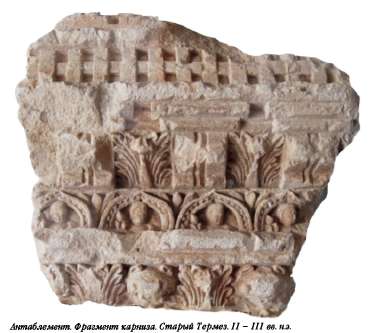 Termez is correlated in the Buddhist the art of the Buddha Shakyamuni. Judging by the finds, this image was circulated in Bactria in the last Kushan epoch, where he is, apart from the stone architectural details, meets the small-scale plastic art, коропластике, etc. Depicted in them the image looks more like a lion, than a tiger. Here he is manifested as the “defender”. At every historical stage image predator changes on the demand of time. The traditional art of the Ancient East, especially Assyria, Babylon and the Achaemenid Persian of Iran, is the image Gryphon. In Bactria in ancient times were widely distributed two types of diomorfnyh images griffins: the lion Gryphon (a winged lion) and bird-Griffin (animal with head of the bird and the wings), i.e. here the animal expresses a symbol of the earth, and the bird is a symbol of the sky. At different times for different the peoples of the griffins were sometimes symbol of goodness, sometimes – crimes. According to Mr. A. Pugachenkova, Griffin was how would talisman against evil spirits and witchcraft. If in Mesopotamia and India had been circulated with the lion wings, then in the art of Iran, Central Asia and the Scythian Siberia – a Griffin with the horns. In contrast to the typical cruise lions he had horns of a spiral shape and expanding ends.
Termez is correlated in the Buddhist the art of the Buddha Shakyamuni. Judging by the finds, this image was circulated in Bactria in the last Kushan epoch, where he is, apart from the stone architectural details, meets the small-scale plastic art, коропластике, etc. Depicted in them the image looks more like a lion, than a tiger. Here he is manifested as the “defender”. At every historical stage image predator changes on the demand of time. The traditional art of the Ancient East, especially Assyria, Babylon and the Achaemenid Persian of Iran, is the image Gryphon. In Bactria in ancient times were widely distributed two types of diomorfnyh images griffins: the lion Gryphon (a winged lion) and bird-Griffin (animal with head of the bird and the wings), i.e. here the animal expresses a symbol of the earth, and the bird is a symbol of the sky. At different times for different the peoples of the griffins were sometimes symbol of goodness, sometimes – crimes. According to Mr. A. Pugachenkova, Griffin was how would talisman against evil spirits and witchcraft. If in Mesopotamia and India had been circulated with the lion wings, then in the art of Iran, Central Asia and the Scythian Siberia – a Griffin with the horns. In contrast to the typical cruise lions he had horns of a spiral shape and expanding ends.
Struggle of animals with it the nomads, perhaps, meant the idea of the struggle of good and evil. This cosmogonic idea developed in the totemic representations, however, it standing above the views. The capitals of the columns and pilasters sometimes resulted in the image griffins-the lions. Believe, what they have come a very long way development, and their appearance in the Bactria scientists associated with the mythological art, created by the imagination of the peoples of ancient Asia, and which has the value of a talisman. The Central Asian griffins were closely connected with the decor monumental architecture, where sometimes, for example in the capitals of the Shahrinaeva, you can meet them the styling. Hellenism brought to the Ancient East freedom of images emotional qualities of nature. According to L. And. Ремпеля, “in the era of the Kushan Empire, gryphons and lions returned ” the art of Central Asia. However, if the look closely at the capitals of the Termez, can you make sure that there Griffin lost the former king’s face and took the form of predatory of the beast.” X. Karamatov, agreeing 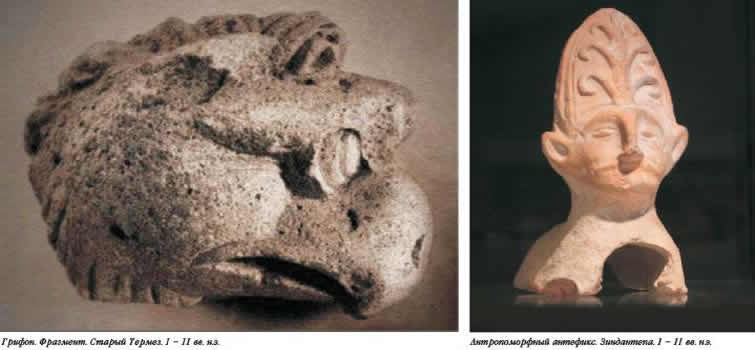 with the opinion of the And. Pyankova, wrote: “With the image of the Gryphon Greeks and Persians got acquainted in Bactria. With the help of their historians they brought him the image of the Bactrian legends”. In the work of the Ktesiya “Indica” (end of V – the beginning of the IV century B.C.) the gryphons of Bactria preserved stories, in which, in particular, noted: “The residents of the Bactrian gold mined in the mountains, however, there are griffins. These birds have four legs and claws, like the claws of lions, a large body of like a wolf. Have wings, but don’t fly The feathers on the breast of red, and the body is black, wings white, beak of the eagle, his eyes burning. Therefore there it is difficult to extract gold , and Bactrians collect gold, уроненное griffins Griffins may not only resist the elephant and lion People in the dark the time of day, hiding from the griffins, go for the gold “. According to the author, the ancient adage, “griffins can’t resist the elephant” entered into a religious tradition and the art. But “later became Griffin positive animals and entered the Buddhist legends as that helps people being.” Ox, a horse, a camel, wild goat, wild boars and other animals in ancient times was reported as a cosmogonic symbols. Ancient people were depicted as a bull in the wall drawings like an animal totem, later he became a symbol of the source of fertility and the man’s beginning. Bull depicted in composite capitals, as well as on the vessels of Kushan period. Passing тотемический, mythical and
with the opinion of the And. Pyankova, wrote: “With the image of the Gryphon Greeks and Persians got acquainted in Bactria. With the help of their historians they brought him the image of the Bactrian legends”. In the work of the Ktesiya “Indica” (end of V – the beginning of the IV century B.C.) the gryphons of Bactria preserved stories, in which, in particular, noted: “The residents of the Bactrian gold mined in the mountains, however, there are griffins. These birds have four legs and claws, like the claws of lions, a large body of like a wolf. Have wings, but don’t fly The feathers on the breast of red, and the body is black, wings white, beak of the eagle, his eyes burning. Therefore there it is difficult to extract gold , and Bactrians collect gold, уроненное griffins Griffins may not only resist the elephant and lion People in the dark the time of day, hiding from the griffins, go for the gold “. According to the author, the ancient adage, “griffins can’t resist the elephant” entered into a religious tradition and the art. But “later became Griffin positive animals and entered the Buddhist legends as that helps people being.” Ox, a horse, a camel, wild goat, wild boars and other animals in ancient times was reported as a cosmogonic symbols. Ancient people were depicted as a bull in the wall drawings like an animal totem, later he became a symbol of the source of fertility and the man’s beginning. Bull depicted in composite capitals, as well as on the vessels of Kushan period. Passing тотемический, mythical and 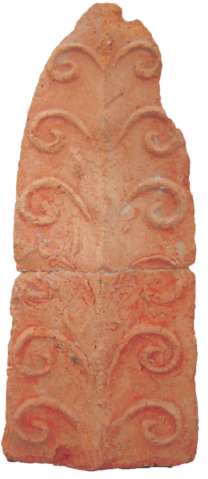 the historical stages, the image of a bull even in ancient times, has turned into a Gavomorda and Gopadhosha.
the historical stages, the image of a bull even in ancient times, has turned into a Gavomorda and Gopadhosha.
As the researchers note, in the age of Hellenism attribute deity and a participant of the cult of worship of secret religious ceremonies have become argali and the goat, which was represented as reflection of the cosmic forces. Thus the perception of being and symbol, a sign of nature are the birds symbolized the deeper human the experiences of the world and the spiritual world. The eagle is the king of birds. His image hold the leading place in the art of the Ancient East and Scythian Siberia as a symbol of the cosmos or dynasty. In the era of antiquity in Central Asia birds of prey were symbols of the the winners of the powerful celestial beings, the embodiment of the force and dexterity, and, keeping his aggressiveness, expressed the sorcery the cosmogony in which the eagle is one of the ancient symbols of the sun. At the stages of heroic epics and livestock he appeared as a symbol of strength and power. There is little information about images on антефиксах in the architecture of Northern Bactria (Халчаян, Dalverzintepa). In some sources acanthus and Palmetta, depicted on антефиксах, are interpreted as the tree of life. On the pieces of many антефиксов found on the hills Халчая- for, in addition to the motives of акантов and palmettes can be found also other vegetative ornaments. The only anthropomorphic image on the антефиксе of Зиндонтепа expresses the same meaning as антефиксы Asia Minor and Этруса, that is, these are interpreted as characters wards off evil spirits of the Holy the place, for they are often used in the temple structures. For example, in Etruscan temples were антефиксы as апотропеи – protection and a talisman against evil spirits.
Teeth-мерлоны, widespread in the architecture of the ancient Middle The East had only functional the value. Later, in the middle of the century, their motives met in the decoration of the Terra-cotta ossuaries, where they were portrayed together with columns and arches and in the aggregate, reflect the views of a the buildings. On representation of fire-worshippers, ossuaries, reminiscent of the architectural construction, served as a refuge for those who have died. Types of images in an architectural the decoration of the vast territories were formed and developed over many centuries. The above examples testify to the fact that images in an architectural decor of not only been used as a constructive or decorative part of the buildings, but have a certain ideological- philosophic meaning. Many of them firmly in the life of the people. Up to now then, at the gates and doors of some houses can be found horns of argali or horseshoe as evidence of devotion to the people of Central Asia the ancient religious and philosophical convictions. Thus, the study of the architectural decor serves not only the coverage of the history of architecture and historical-cultural territory, and the expansion of information on the life the attitudes, perceptions and aspirations of our ancient ancestors.
Akmal Ulmasov
